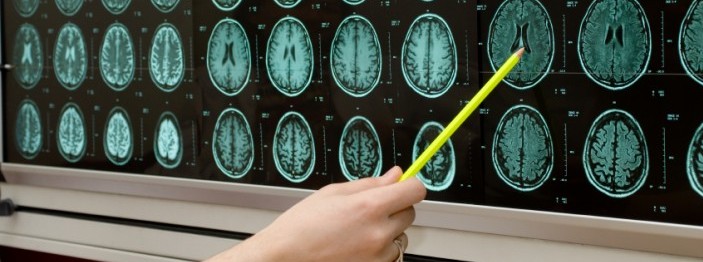What is an MS lesion?
During the course of multiple sclerosis, doctors will often talk about “MS lesions” that are visible on your MRI (magnetic resonance imaging) scan. But they may not fully explain what these lesions are, and why they are significant.
Lesions (or “plaques”) have been recognized as a characteristic feature of MS for over a century (Rindfleisch and colleagues. Arch Pathol Anat Physiol Klin Med (Virchow) 1863;26:474-483). At the time, the only way to examine them was to wait until the person had died, and then perform an autopsy. People had to wait until the 1990s, when MRI became more widely used, to be able to see how these lesions changed and evolved during a person’s life.
Lesions are discrete areas of tissue damage in the brain and spinal cord, and can be caused by many things, such as infection, head trauma, stroke, etc. But with MS lesions, a common feature is that they contain immune cells (Lucchinetti and colleagues. Ann Neurol 2000;47:707-717). The composition of individual lesions differs, and one person can have different types of lesions at the same time. In part, the differences in lesion types may be due to the genetics of the individual, which will influence how the immune reaction develops and how healing occurs. But lesion differences can also reflect different stages in the evolution of the lesion.
MS lesions are caused by immune cells that enter the central nervous system and cause inflammation. This is one of the reasons why MS is thought to be an autoimmune disorder and why MS medications are used to target this inflammation. The immune cells found in MS lesions are primarily of two types: T cells, which promote inflammation and direct the immune attack; and macrophages, which clean up the damage caused by this immune process. Some of the newer MS medications (e.g. Aubagio, Gilenya) reduce inflammation in the brain by specifically targetting these T cells.
When a lesion first develops, it also contains some of the brain’s own immune cells (called microglia), which join in the immune reaction. At a later stage, some lesions contain antibodies produced by another type of immune cell called B cells, and these B cells may play an increasingly important role as MS develops. One of the treatment approaches that is emerging in MS research is to target these B cells. Lemtrada acts on B cells and T cells, and two medications in development (ocrelizumab and ofatumumab) only affect B cells.
Also found in MS lesions is evidence of the crime: tissue debris, as shown by damaged or missing proteins and myelin from what had once been intact nerve fibres. Damaged nerve fibres are what cause MS symptoms, and the location of the lesion can be inferred by the type of symptoms you’re having. Damage to sensory nerve fibres can cause tingling, numbness or pain; damage to motor nerve fibres can cause muscle weakness or tension; and so on. The symptoms are felt in the body, but the source of the problem is the lesions in the brain and spinal cord.
Inflammation flares up and resolves on an ongoing basis, but is often “clinically silent”, i.e. not associated with symptoms. However, about 10% of lesions will be bad enough that you will experience a worsening of your MS symptoms (i.e. a relapse).
MS lesions change over time. An analogy would be a lesion on your skin: it goes from being a red, raised wound (the inflammatory stage), to forming a scab (healing), to perhaps leaving a scar (an area of incomplete healing).
The evolution of MS lesions can be seen with an MRI. When a contrast dye (called gadolinium) is used, a new MS lesion appears as a bright disc on the brain image. This is called an enhancing lesion. The brightness represents an area of swelling (e.g. increased fluid) as the region becomes inflamed. The excess fluid is slowly reabsorbed, so that enhancing lesions typically disappear within 3-4 weeks.
If a contrast dye isn’t used, the MRI machine can be set to capture different types of images. Most enhancing lesions also appear as bright spots (called hyperintense T2 lesions) or dark spots (called T1 lesions) (the different types of MRIs are beyond the scope of this article). T2 lesions usually shrink in size but the process is more gradual, lasting about 3-5 months (Rovira and colleagues. Ther Adv Neurol Disord 2013;6:298-310). In the initial phase, this shrinkage is because the swelling is going away. Later shrinkage is due to healing of damaged tissues, as well as loss of tissue (from macrophages clearing away the debris). A lesion that shows evidence of repair is called a shadow plaque (neither light nor dark) because it doesn’t light up like an inflammatory lesion, but it still doesn’t look like the undamaged healthy tissue surrounding it. To continue with the skin analogy, once the scab is removed, the healed area doesn’t look like the rest of your skin.
Most lesions will heal, but they often leave behind a “footprint” of where they had been. In essence, this is the scarring (the hardening or “sclerosis”) that gives multiple sclerosis its name.
Some lesions aren’t able to repair themselves, in part because the specialized cells that produce myelin are damaged or dead. Damaged repair cells are more commonly found in older lesions, or lesions in someone with primary-progressive MS. On an MRI, these lesions can ultimately “go dark” (called hypointense T1 lesions, or black holes) – a sign that in that area the nerves fibres have been permanently lost. This cumulative loss of tissue will shrink the brain (called atrophy) at a rate that is much higher in people with MS compared to people without MS (everyone’s brain shrinks due to normal aging). As you might expect, losing tissue puts the person at a very high risk of losing function – so it’s critical to start treatment as early as possible to slow down the rate of brain loss.
MRIs are performed most often in the first few years after an MS diagnosis and provide a frame-by-frame film of the lesions as they form in the brain and spinal cord.
There are two main reasons why this matters. The first is that MRI lesions show you the disease process that is going on in your brain – inflammation and tissue damage of which you might otherwise be unaware. More lesions mean more damage, and many doctors will now show you the MRI to illustrate why you need to start a medication. MS medications can quickly reduce the inflammation in your brain, which means there is less damage for your body to try to heal. It’s the same principle as taking an Aspirin or ibuprofen to reduce the swelling when you have a twisted your ankle – the purpose of inflammation is to heal, but ongoing inflammation can damage tissues. It needs to be controlled.
When you are first diagnosed with MS, it’s impossible for your doctor to be able to predict how well you’ll do over the longer term. But the number of lesions on your MRI in the first few years after your diagnosis is a very good indictor of the severity of your MS.
Once you’ve started treatment, MRIs will also tell you quickly if the drug is working. MS medications target inflammation in different ways and it isn’t known how well an individual will respond to a specific treatment. At the very least, a drug should reduce inflammation – stop lesions from forming as quickly and completely as possible. And according to a recent analysis of treatment studies, the actual number of new lesions – a measure of the extent of ongoing inflammation in the brain – was one of the best predictors of how much disability will develop over the next few years (Fahrbach and colleagues. BMC Neurology 2013;13:180). So if new lesions continue to form after starting a medication, it’s a good indication that you’ll need another treatment. During the course of MS, it’s essential to do as much as you can to prevent the damage that lesions cause in your brain and spinal cord.
Share this article
Facebook Twitter pin it! Email
Related Posts
Back





